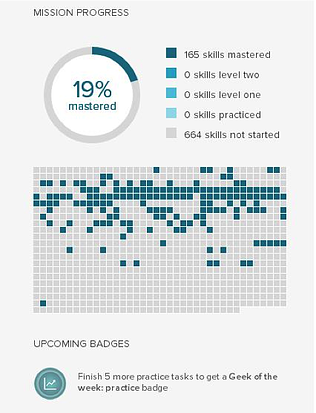Blog
5 Common Missteps In Onboarding Programs
by Hannah von Bank, relationship management assistant

.png?width=1387&height=526&name=hannah(250).png)
3 Tips for Harnessing the Power of Habit in Your e-Learning
By Hannah Hunter | March 10, 2014 | Custom Learning | 0 Comments
by Hannah von Bank, relationship management assistant
.png?width=120&height=120&name=hannah(250).png)
Habits―everyone has them. Duke University recently calculated that about 40% of the actions we take each day are governed by habit rather than a conscious decision. They are the brain’s way of saving time and energy on tasks we complete often—like brushing our teeth or driving the same route to work every day.
Are your learners scoring well on written assessments but not adequately applying their skills on the job? This conundrum may well be due to deeply ingrained habits rather than lack of knowledge or effort, especially if your learners are trying to adjust to a recently introduced or changed process or policy. The good news is, by learning about the science of how we make and break habits, training and development professionals can help their learners develop good ones.
Making and Breaking Habits
Before you try to change an ingrained behavior, you must learn to play by the brain’s rules. All habitual behaviors adhere to an equation called a habit loop:
Cue (trigger) + routine (behavior) + reward + repetition = habit
Every day when I turn on my computer (cue) I drink my coffee (routine) which makes me feel alert (reward). Depending on how often I get my morning caffeine fix, it will take anywhere from 21-100 days for this conscious behavior to become a habit. After repeating this cycle enough times, I now crave coffee whenever I turn on my laptop.
.jpg)
Asking the Right Questions
As learning professionals, we are most often asked to concentrate on the “routine” aspect of this equation―in other words, the problem behavior. While this is definitely important, it is equally vital to recognize the cues and rewards that motivate our learners to behave the way they do. When you meet with your stakeholders (and hopefully some past or future learners), consider these questions:
- Why are learners engaging in this problem behavior? Do they understand the expectations set for them? If they do, but are choosing to do something else instead, then you ought to wonder, what is motivating them to perform this way and how can we use that reward to support your learning goals? Cutting corners on paperwork may seem like a great time saver for a busy worker. Perhaps we could streamline the paperwork process, design a module or workshop to teach time management skills, or simulate the headaches that can happen when paperwork is missing vital information. Your learners will appreciate you recognizing and responding to their challenges.
- When do mistakes happen? Does performance lag or excel at certain times or in certain situations? Understanding the cue that triggers learners to perform one way or another is an important factor in designing a focused course. Your call center employees may be well versed in their talking points and product offerings, but perhaps they get nervous and fumble when they encounter an irate customer. In this case, focusing your training on handling objections or difficult situations would allow you to facilitate more practice of the learner’s specific problem areas than you could if you had to use your resources to create a broader course.
3 Tips: Designing for Habit Change
Once you’ve focused your content around your learners’ specific problem area, it is time to create! Of course, Allen Interactions’ CCAF-based Design Model is always applicable to developing any kind of learning—and you will, not coincidentally, notice some overlap between CCAF and the tips below.
- Creating for Cues – As we discussed above, habits are, in part, determined by cues that are dependent on an individual’s environment. This is why it is vital to replicate or simulate these cues in a “real world” context. An interface that puts the learner in a role that is familiar to them, either visually or through textual scenarios, will be much more meaningful, and ultimately effective, than an interface that looks like a Jeopardy game.
- Creating for Routine – Creating a new habit can take anywhere from 21-100 days of performing an activity repeatedly. Aim to develop training that is highly interactive, that closely replicates the problem situations you identified, and is reviewed and reinforced regularly. Using blended learning elements is a great way to reinforce your training on a budget. For example, learners may begin by taking a focused, 1 hour e-learning course that includes several role-play scenarios. They may be given a short print out of key points to keep at their desks in case of questions. In the next weeks they might meet with a small group of peers to discuss the learning or role-play additional scenarios. However you chose to do it, practice, practice, practice is the name of the game.
- Creating for Reward – There are a number of ways you can create rewards in your e-learning and on the job. Here are just a few:
- Give positive feedback – While we want learners to be aware of where they can improve, too harsh a critique may leave learners feeling demoralized. An unhappy learner is rarely a productive one. Recognize what your learners excel at in addition to where they can improve and try to incorporate those positives into your feedback.
- Make it fun – Adding humor, a story, interesting graphics, and/or interactive, even game-like elements to e-learning is a great way to keep learners engaged and motivated to complete the course. Having fun is its own reward and as an added bonus, learners may want to complete a “fun” course more than once.
- Make it competitive – Winning is intrinsically rewarding whether you are competing against a colleague or yourself. Adding a high score chart, letting learners “level-up” as they master more advanced material, and recognizing top performers on-the-job are good ways of fostering competition and that winning feeling.
I hope I’ve given you some ideas to ponder and tools to use when creating your next training project. The theories discussed in this post were inspired by an excellent book, The Power of Habit, by Charles Duhigg. Have you read an interesting or thought-provoking book or article recently? Since I am now out of reading material, I’d love to hear your recommendations. Write them in the comments below!

About the Author: Hannah Hunter
Hannah Hunter is an instructional writer at Allen Interactions. When she’s not sharing her passion for life-long learning, Hannah enjoys painting, experimenting with new recipes, and volunteering as a creative writing tutor for middle and high school students. She also frequently blogs on Allen Interactions’ e-Learning Leadership Blog.
Comments
Would you like to leave a comment?
Related Blog Posts

By: Hannah Hunter | Sep, 2014
Category: Custom Learning, Strategic Consulting

Blog
Free Online Courses to Exercise Your Brain this Summer
by Hannah von Bank, relationship management assistant
By: Hannah Hunter | Jul, 2014
Category: Custom Learning
.png?width=316&name=hannah(250).png)
Blog
Tips for Developing Successful Leadership Training
by Hannah von Bank, relationship management assistant
By: Hannah Hunter | Apr, 2014
Category: Custom Learning


